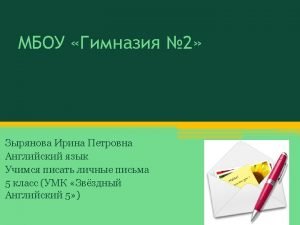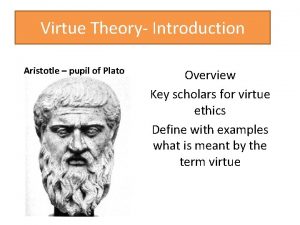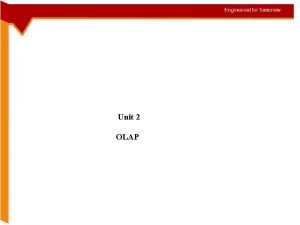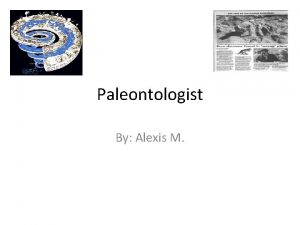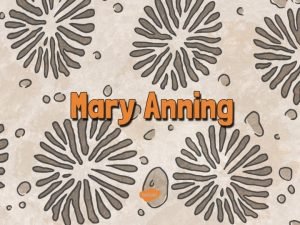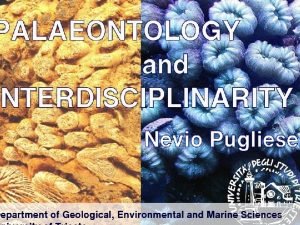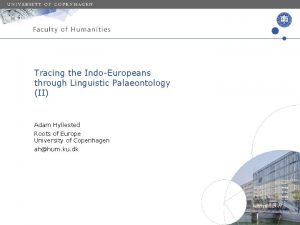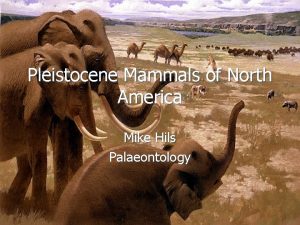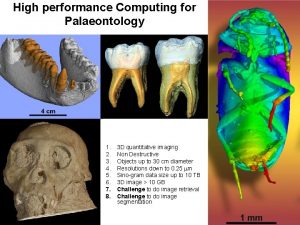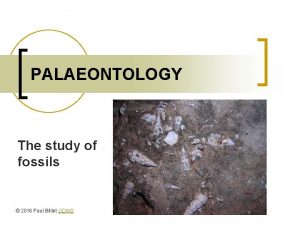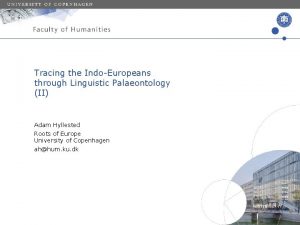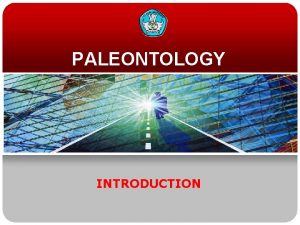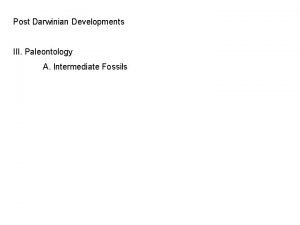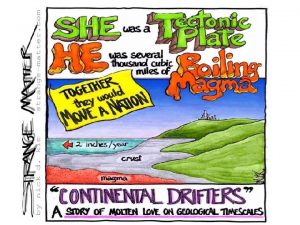INTRODUCTION to PALEONTOLOGY Dr Masdouq AlTaj 20162017 PALAEONTOLOGY


















































- Slides: 50

INTRODUCTION to PALEONTOLOGY Dr. Masdouq Al-Taj 2016/2017

PALAEONTOLOGY Introduction What is palaeontology? • From Greek : Palaeo ( old, ancient ) ont (being, creature) and logy (Science). • It is the study of prehistoric life. It includes the study of fossils to determine: • organisms ' evolution • Interactions with each other • Their environments (paleoecology).

PALAEONTOLOGY Introduction What is palaeontology? Palaeontology: is the study of ancient life through its fossil remains or the traces of its activity as recorded by ancient sediments. By studying the fossils in older rocks, the paleontologist attempts to establish an account of how all the animals and plants, which make up the modern biosphere evolved from their earliest beginnings. Hashemite university

PALAEONTOLOGY Palaeontology: divided into: • Micropaleontology: is the branch of palaeontology that studies microfossils. • Palaeobotany: The study of fossil plants. • Palaeoecology: the study of fossil communities environment. • Palynology: the study of pollen and spores

What is a fossil? A fossil is an impression, cast, original material or track of any animal or plant that is preserved in rock after the original organic material is transformed or removed.

A fossil may be: • an original skeleton or shell; • a mold or cast; • material that has replaced the once living thing; • traces such as footprints or worm tubes

PALAEONTOLOGY What is a fossil? • There are two types of fossil: • Body fossils: the actual remains of organisms. • Trace fossils: are indirect signs of life; dinosaur footprints, worm burrows ( )ﺣﻔﺮ ﺍﻟﺪﻳﺪﺍﻥ , trilobite grazing trails ( ﺛﻼﺛﻴﺎﺕ ﺍﻟﻔﺼﻮﺹ )ﻣﺴﺎﺭﺍﺕ ﺭﻋﻲ , and other evidences of life processes, such as fossil excrement ( ﺍﻟﻔﻀﻼﺕ ) (examples: coprolites ������ stomach dung) and Gastroliths (highly polished stone used by reptiles).


PALAEONTOLOGY Introduction What are the conditions that are favorable for fossil preservation? 1. The possession of hard parts vastly increases an animals’ chance of being successfully fossilized. 2. Rapid burial and/or lack of oxygen encourages good preservation.

PALAEONTOLOGY Introduction • Fine grained sediments are also good for preserving fossils, on account of their low oxygen content. • Organisms living in water, especially seawater, always have the best preservation potential. • Animals and plants living on land stand the poorest chance of preservation. Hashemite university

PALAEONTOLOGY Introduction Of what materials are "hard parts" composed? • Invertebrate animals may have durable ( )ﺩﺍﺋﻢ external skeletons such as shells ﺃﺼﺪﺍﻑ And even soft-bodied invertebrates such as worms may have some resistant components (jaw )ﻓﻚ. Common, preservable skeleton substances include: • Silica (Si. O 2) silicon dioxide; highly resistant material which forms the skeletal elements (spicules ����� ) of certain sponges. Hashemite university

PALAEONTOLOGY Introduction • Calcite (Ca. CO 3), calcium carbonate; calcite is stable crystal form. • Aragonite Ca. CO 3; less stable out of seawater than calcite, it is very common shell material. After burial, aragonite may change to calcite or be dissolved out and replaced by another mineral. Many Molluscs ( )ﺍﻟﺮﺧﻮﻳﺎﺕ have aragonitic shells. Hashemite university

PALAEONTOLOGY Introduction • Chitin: is a polysaccharide-a complex, insoluble organic substance made of carbon, nitrogen, hydrogen and oxygen atoms joined in chains to form long molecules. It is commonly preserved. Insects ( )ﺍﻟﺤﺸﺮﺍﺕ exoskeletons are made of chitin. The trilobites possessed chitinous carapaces ﺩﺭﻉ which were further strengthened by impregnation ﺗﺘﺸﺮﺏ with mineral substances. Hashemite university

PALAEONTOLOGY Introduction • Scleroprotein ������ : another group of complex substances, insoluble in water, which form tough covering of certain animals. Substances such as Keratin and Collagen fall into this group. They are fibrous proteins and they formed the skeletons of the graptolites. Molluscas also make use of fibrous protein; Conchiolin. Hashemite university

PALAEONTOLOGY Can a complete organism become fossilized? • YES. 1. By Natural refrigeration under glacial conditions ﻇﺮﻭﻑ ﺟﻠﻴﺪﻳﺔ. In Siberia and Alaska has preserved the carcases ﺟﺜﺚ of Mammoth (large hairy kind of elephant) and Rhinoceros ﻭﺣﻴﺪ ﺍﻟﻘﺮﻥ 2. Amber is fossilized tree resin ﺻﻤﻎ , and since it is very sticky when it first emerges, insects are often captured upon its surface and later entombed ﺗﺪﻓﻦ ﺍﻭ ﺗﻘﺒﺮ. Hashemite university

PALAEONTOLOGY 3. Peat bogs, decay are seriously inhibited in peat bogs, and animals may be beautifully preserved. 4. In areas where natural petroleum seeps to the surface, tar pools or asphalt lakes may form, they are dangerous traps for animals of all kinds. 5. In very hot, dry regions, the corpses (body) of animals may be dried so quickly as to prevent decay. The skeleton is preserved "mummification". Hashemite university


PALAEONTOLOGY What are the main changes during fossilization "diagenesis"? Mode of fossils preservation • Recrystallization: molluscan groups; gastropods and cephalopods, have aragonitic shells. Aragonite is unstable out of seawater. No sedimentary rock older than Mesozoic will contain aragonite. Aragonite may invert to the stable polymorph of calcium carbonate; Calcite. In such cases, the original microstructure of the shell may be preserved in the new mineral. More commonly, the aragonite will dissolve to leave a void. Hashemite university

PALAEONTOLOGY Introduction • Replacement: the void left by the dissolution of an aragonite is called mold ﻗﺎﻟﺐ. This mold may be infilled at a later date by the precipitation of another mineral (Cast). This may be calcite, but it could also be silica. • If dissolution and replacement are separated by a void stage, all the original microstructure is lost. Hashemite university

PALAEONTOLOGY What are molds and casts? The sediment, which bears the imprint of the shell’s outer surface is referred as the external mold. The sediment which filled the body cavity and bears the imprints of the internal features, is referred to as the internal mold, it is also sometimes called by the German name Steinkern. Hashemite university


PALAEONTOLOGY Introduction • If percolating solutions should precipitate some mineral within the void, then the resulting replica of the fossil is called cast. Hashemite university

PALAEONTOLOGY Introduction • Replacement by another minerals such as iron minerals: pyrite=Iron sulphide; (Fe. S 2), siderite (iron carbonate= Fe. CO 3), limonite (iron oxide= Fe. O), and hematite (iron oxide =Fe 2 O 3) is commonly seen. • Only Pyrites forms well-preserved fossils, and these must be protected from oxidation once they have been removed from the rock. Hashemite university

PALAEONTOLOGY Introduction • Permineralization: this is the partial replacement or impregnation of original material by mineral salts. • Bone and wood are highly porous and so is susceptible to this form of petrifaction. • Carbonization – tissue material is decomposed or reduced to a film of carbon Hashemite university

PALAEONTOLOGY Introduction How do fossils "date" rocks? • Stratigraphy: is the study of how layered rocks and their contained fossils are distributed in space and time. • But, beds of rock are very frequently found to have been disturbed by folds and faults; and over large distances, any particular bed may change in thickness and composition. Hashemite university

PALAEONTOLOGY Introduction • Thus it may not be possible to match beds of the same age in distance places, and even if we could, the fact that the rocks have the same composition is no guarantee that they were formed at the same time. Fossils provide us with an answer to this problem. Hashemite university

PALAEONTOLOGY Introduction • Since life is forever changing through time, with species continuously arising and becoming extinct, it is possible to identify strata by means of their enclosed fossils, since these fossils may not occur in bed either older or younger. • In practice, strata are actually zoned by the first appearance of the zone fossil, an event which extends like a" time contour "through rocks of that age everywhere. Hashemite university

PALAEONTOLOGY Introduction Index fossils 1. Worldwide distribution, occurring in all sediments irrespective of depositional environment. • In the sea, free-living swimmers or floaters will live independent of bottom conditions, and should therefore be good zone fossils if preserved such as "pollen & spores". Hashemite university

PALAEONTOLOGY Introduction 2. Species should be short-lived, i. e. the forms should display rapid evolution. This is necessary for the correlation to be a fine one, indicating precise equivalence rather than broad ones. Hashemite university

PALAEONTOLOGY Introduction In the lower Paleozoic , the graptolites provide perhaps the best example of zonal macrofossils, and in the Mesozoic the ammonites provide a time stratigraphy which is almost unrivalled ﻻ ﻣﺜﻴﻞ ﻟﻬﺎ. Hashemite university

PALAEONTOLOGY Introduction • The first appearance of a particular species defines the base of a zone, which is that thickness of rock between the appearance of one zone fossil and the arrival of the next. The zone is named after its characteristic fossil; thus the Jurassic ammonite Zigzagiceras zigzag defines the zigzag zone (the term zone refers to rock thicknesses). The time during which the zone fossil held its way is known as a chron. Hashemite university

PALAEONTOLOGY Fossils occurring in situ Organisms which are fossilized in the place where they lived and died are said to occur in situ. Fossils which have been moved from their habitat to another area for burial are said to be transported.

PALAEONTOLOGY Introduction Derived fossils The erosion of a fossiliferous rock may release fossils into streams, and may deposit in younger sediments, so could be a source of confusion when a stratigrapher tries to date the younger sediments. This is not common, but fossils recycled in this way are called derived fossils. Hashemite university

PALAEONTOLOGY Introduction Fossils as indicators of environments • Certain animals are known to have very definite environmental requirements and therefore very selective about where they live. Modern corals, only survive above 90 meters depth in the open ocean, and they only thrive and building reefs above about 40 meters. The water must not drop below ~ 20ºc, and they can tolerate neither cloudy water nor any deviation below normal salinity. Hashemite university

PALAEONTOLOGY Introduction By the principle of uniformity, wherever we find fossil reefs composed of modern (Scleractinian; dated from the Mesozoic) corals, we can say that conditions like these also prevailed in the ancient. ● ﺍﻟﺤﺎﺿﺮ ﻣﻔﺘﺎﺡ ﺍﻟﻤﺎﺿﻲ ● Hashemite university

PALAEONTOLOGY Introduction • Recently, it has been discovered that the ratio of the two oxygen isotopes O 16 and O 18 found in the shells of marine invertebrates reflects the temperature of the water in which they live, warmer conditions encourage the increase of the heavier O 18. Corals growth a little every day. The daily growth bands are grouped into monthly bands; they found that the Devonian year is 399 days (13 months of 30. 6 day in the month). Hashemite university

PALAEONTOLOGY What is Taxonomy? • Over a million species of animals alone have already been described. • Generic classification; it is based upon origin and common ancestry ﺃﺼﻞ. • The fundamental unit of biological classification is the species ���. • All members of a species share a range of features not shared by any other group.

PALAEONTOLOGY Introduction • Inherent ﺍﻟﻮﺭﺍﺛﺔ in this unity of appearance and shape is the notion that all members of a species may interbreed successfully to produce viable offspring ﺫﺭﻳﺔ in the natural state. Sometimes in captivity ﺃﺴﺮ animals of different but closely related species may interbreed ﻫﺠﻴﻦ and produce offspring which, to some extent, share the properties of their parents and which may also have distinct characteristics of their own; the horse and donkey will produce the mule, these animals are called hybrids.

PALAEONTOLOGY Introduction • Similar species may be grouped together in larger categories whose member species more closely resemble each other (i. e. have more things in common) than species of another group. The larger group is called the genus (pl. genera). • The scientific name of any animal composed of two words called a binomen. Hashemite university

PALAEONTOLOGY Introduction • The first name, which is always written with a capital letter, denotes the genus and is called the generic name. The species or specific name comes after, and has no capital letter. In printed books, such names are always written in italics. • When you write them yourself, or have your manuscript typed, they must be underlined. Hashemite university

PALAEONTOLOGY Introduction • The names themselves are chosen to be descriptive, they may also be dedicatory ﻷﺤﺪ ﻣﺎ ﺇﻫﺪﺍﺀ. Descriptive names are taken from Latin or Greek, and even when a species is named after somebody, the name must be Latinized. Hashemite university

PALAEONTOLOGY Introduction • Canis familiaris: The domestic dog. • Canis = dog. • Familiaris = belonging or relating to a family or household. Hashemite university

PALAEONTOLOGY Introduction • Homo sapiens ������ : The human being • Homo = a man (L). • Sapiens = sensible, judicious, wise (L). Hashemite university

PALAEONTOLOGY Introduction • This system of naming has been with use since it was set out by the Swedish botanist ﺍﻟﻨﺒﺎﺗﻲ CARL VON LINNÉ (1707 – 1778), more commonly known by Latinized name Linnaeus, in his book Systema Nature (The system of Nature) in 1758. Hashemite university

PALAEONTOLOGY Introduction § Similar genera ﺃﺠﻨﺎﺱ are grouped into families, families into orders, orders into classes and classes into the greatest division of all, the phylum (the names of these groups are slightly different in botany ﻋﻠﻢ ﺍﻟﻨﺒﺎﺕ , but the principle of classification is the same). Hashemite university

PALAEONTOLOGY Introduction • There are over twenty phyla (Pl. of phylum) in the kingdom Animalia, some containing millions of species, some only a few. • Kingdom Animalia • Kingdom planta • Kingdom Monera ; ﻭﺣﻴﺪﺍﺕ ﺍﻟﺨﻠﻴﺔ one cell, contain cytoplasma and nucleus. • Kingdom Fungi ﺍﻟﻔﻄﺮﻳﺎﺕ • Kingdom Protista ; ﺍﻷﻮﻟﻴﺎﺕ uni-cell, motile ﻣﺘﺤﺮﻛﺔ Hashemite university

Kingdom: Animalia Phylum: Chordata ���� class: Mammalia���� order: Primata ������� �� ����� family: Hominidae ���� �� Genus: Homo ﺍﻻﻧﺴﺎﻥ Species: sapiens our scientific names is just Homo sapiens. Com - Atlantic bluefin tuna, Sc - Thunnus thynnus Kingdom: Animalia Phylum: Chordata Class: Actinopterygii Order: Perciformes Family: Scombridae Tribe: Thunnini Genus: Thunnus Species: T. thynnus

PALAEONTOLOGY Introduction • Kingdom Ainmalia: all animals • Subkingdom Metazoa: all animals containing of more than one cell • Phylum Chordata: possessing an axial, dorsal nerve cord ﻇﻬﺮﻳﺔ ﺍﻟﻌﺼﺒﻴﺔ ﺍﻟﺤﺒﻞ • Subphylum Vertebrata nerve cord surrounded by a bony spine ﻋﻈﻤﻲ ﺍﻟﻌﻤﻮﺩ ﺍﻟﻔﻘﺮﻱ • Class Mammalia young, brain nursing hair, oftrue of advanced type Hashemite university

PALAEONTOLOGY Introduction • Order Primates • Suborder Anthropoidea • Family Hominidae • Genus Homo • Species sapiens Hashemite university mostly tree-dwelling placental mammals ﺍﻟﻤﺸﻴﻤﺔ ﻣﺴﻜﻦ monkeys, apes (tailless monkeys , and man and his immediate ancestors man sensible, judicious, wise

PALAEONTOLOGY Introduction Numerical taxonomy • French botanist called MICHEL ADANSON (1727 – 1806). Using an appropriate program, a computer can analyze similarity over the whole range of attributes, plotting its results in a way, which displays this resemblance graphically in a dendrogram (family tree) form. Hashemite university
 Altaj polimetally
Altaj polimetally Intro paragraph layout
Intro paragraph layout Learning without burden is associated with
Learning without burden is associated with Introduction to yacc
Introduction to yacc Dare essay rubric
Dare essay rubric Introduction of an essay example
Introduction of an essay example Abstract vs introduction
Abstract vs introduction Long introduction
Long introduction Topics to write an email
Topics to write an email Conclusion paragraphs
Conclusion paragraphs Introduction answer the question
Introduction answer the question Informative essay example
Informative essay example Praise editorial example
Praise editorial example Advantages and disadvantages of essay
Advantages and disadvantages of essay Introduction of a research proposal
Introduction of a research proposal Diary entry in past tense
Diary entry in past tense Characterization essay example
Characterization essay example Three chunk paragraph
Three chunk paragraph Introduction to mesopotamian civilization
Introduction to mesopotamian civilization Portfolio in work immersion
Portfolio in work immersion Wireless communication introduction
Wireless communication introduction Band introduction speech
Band introduction speech Introduction of personal selling
Introduction of personal selling Humor introduction
Humor introduction Opening and closing remarks for informal letters
Opening and closing remarks for informal letters Thematic essays examples
Thematic essays examples What are the qualities of good writing
What are the qualities of good writing Seminar on smart note taker
Seminar on smart note taker Introduction to e business
Introduction to e business Introduction to semiconductors
Introduction to semiconductors Introduction of infosys
Introduction of infosys Introduction of transport
Introduction of transport Introduction to acids and bases webquest
Introduction to acids and bases webquest Introduction to dynamic web content
Introduction to dynamic web content Pollution introduction
Pollution introduction Aristotle pupil
Aristotle pupil Introduction of purification of water
Introduction of purification of water Victorian poetry introduction
Victorian poetry introduction Victorian era literature characteristics
Victorian era literature characteristics Biographie victor hugo
Biographie victor hugo Vegetable production introduction
Vegetable production introduction Anecdote paragraph example
Anecdote paragraph example Physiology of urine formation
Physiology of urine formation Hypourecemia
Hypourecemia Introduction of personal selling
Introduction of personal selling The odyssey and epic poetry an introduction part 1
The odyssey and epic poetry an introduction part 1 Introduction to olap
Introduction to olap Enduring issues essay outline
Enduring issues essay outline Diff between primitive and nonprimitive
Diff between primitive and nonprimitive Introduction to computer organization and architecture
Introduction to computer organization and architecture Unit 1 introduction to accounting
Unit 1 introduction to accounting
























